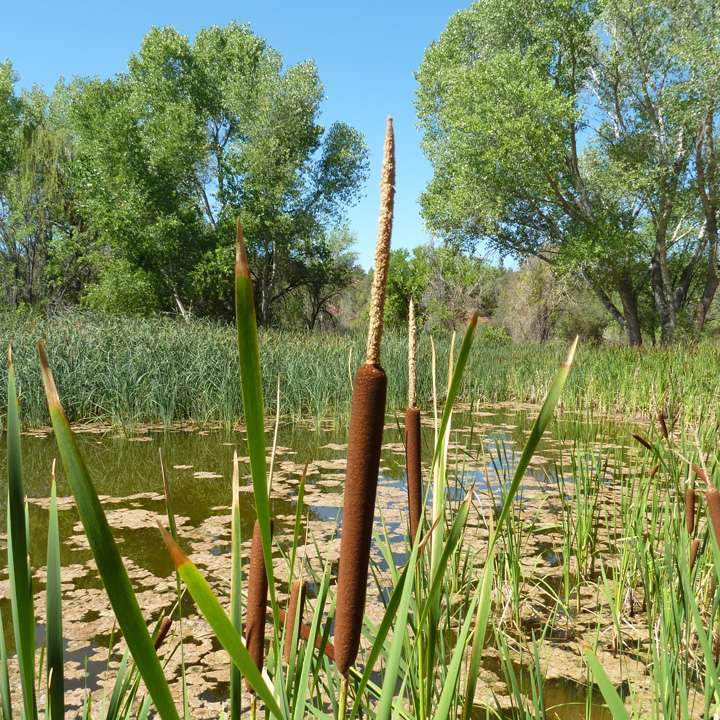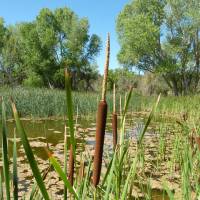Plants of fresh to slightly brackish wetlands, often emergent. Rhizomes at base of erect shoots, mostly horizontal, unbranched, to 70 cm 5--40 mm, starchy, firm, scaly. Erect shoots vegetative or flowering, single at rhizome apices or arising from shoot bases, thus clustered, unbranched, to 4 m, elliptic in cross section; stems often somewhat compressed distally, aerenchyma absent. Foliage leaves persistent, intergrading proximally with scale leaves, to 15 on each flowering shoot; blade twisted into loose helix, mostly slightly oblanceolate, thickly concave-convex or plano-convex proximally to thinly plane distally (abaxially keeled in the Old World Typha. eleiphantina Roxburgh); mucilage-secreting glands numerous in adaxial surface of sheath and sometimes proximally on blade, colorless to brown, roughly rectangular. Inflorescences: staminate scales shorter than or exceeding flowers; pistillate spikes usually persisting into winter, when dry fruiting flowers often falling in masses; pistillate bracteoles absent or numerous, colorless except for brown apical blade at spike surface, filiform, blade club-shaped to lanceoloid. Staminate flowers: anthers dehiscing longitudinally, 4-sporangiate. Pistillate flowers: pistil hairs colorless and wholly filiform, or apically enlarged and brown, exceeded by stigmas; carpodia obovoid, spongy, bearing rudimentary styles. x = 15.
Typha is ecologically important in many fresh to slightly brackish wetlands, often emergent in up to 1.5 m of water. Each spike may produce hundreds of thousands seeds, which are efficiently wind-dispersed and germinate on bare wet soils or under very shallow water. The seedlings rapidly form clones by means of rhizomes in the first season, flower the second season (R. R. Yeo 1964), and often form very large, persistent, often monospecific stands. Some species produce large amounts of biomass, comparable to the most productive agricultural crops. The three species are ecotypically well differentiated in North America (S. J. McNaughton 1966). Some mechanisms of competition between Typha species were studied by J. B. Grace and R. G. Wetzel (1982) and J. B. Grace (1988) (cf. Thieret and Luken 1996; , J. B. Grace and J. S. Harrison 1986).
Common teratological forms are longitudinally split pistillate spikes (caused by parasitic insects), pistillate spikes interrupted by zones of naked axis, and partially merged pistillate and staminate spikes.
Typha species are or have been utilized in numerous ways worldwide (C. M. Finlayson et al. 1983; J. B. Grace and J. S. Harrison 1986; J. F. Morton 1975; V. Ramey 1981; J. W. Thieret and J. O. Luken 1996). Leaves are used for dwellings (walls, roof thatch, floor coverings); for mats, baskets, and other handicraft objects; for caning chairs; and for caulking barrels, boats, and houses. 'Fluff' from fruiting spikes is used for tinder and insulation; for dressing burns; and for stuffing pillows, quilts, mattresses, life preservers, toys, and diapers. Young shoot bases, young rhizomes, starch from mature rhizomes, staminate flowers before anthesis, and pollen are all minor sources of food. Typha is valuable as habitat and food for many kinds of wildlife. It is useful for removal of various kinds of pollutants; a potential source of fiber for paper and other products; and a potential source of energy, e.g., for alcohol manufacture. The seeds comprise about 18--20% of an edible oil (69% linolenic acid). Several species are cultivated as ornamentals. The North American species are often sold commercially and planted for wildlife habitat and in wetland restoration.
The larger Typha species and T. glauca can be serious weeds in managed aquatic systems worldwide, where they can invade canals, ditches, reservoirs, cultivated fields, and farm ponds; they can be a nuisance in recreational lakes; and they can reduce biodiversity and displace species more desirable for certain kinds of wildlife (J. B. Grace and J. S. Harrison 1986; J. F. Morton 1975; J. W. Thieret and J. O. Luken 1996).
Users of this treatment should be aware of the following: 1) Leaves shrink considerably in width as they dry. 2) Leaf mucilage glands are usually colorless and difficult to see in fresh leaves of all three species early in the season and in Typha latifolia at all stages. They are brown and clearly evident to the unaided eye in mid- to late-season fresh or dried T. angustifolia and T. domingensis and are easily stained (with, e.g., safranin). Brown necrotic spots, apparently caused by feeding arthropods, may superficially resemble mucilage glands. 3) Spikes are commonly poorly developed as a result of drought or other causes; fruiting spike thicknesses given herein are for normal spikes. 4) Except for the presence of mucilage glands on the leaf blades, unique to T. domingensis and its hybrids, the microscopic flower and bracteole structures are generally essential for accurate identification of Typha species and hybrids. This is in part because of changes in the inflorescences during development and in part because of phenotypic plasticity, especially of leaf blade widths. It is often necessary to use forceps to pull a few pistillate flowers out of the spike and observe them with a dissecting microscope at 20´ X to 30´ X. 5) Pollen is often infested with fungi, which attach the grains together and simulate genetically aborted grains, and the grains of T. angustifolia and T. domingensis often adhere in small groups for no obvious reason.
Hybrids: Putative hybrids among the three North American species have been experimentally produced and occur in most regions of sympatry and have been experimentally produced (S. G. Smith 1967, 1987). Local studies were provided (J. R. Dugle and T. P. Copps 1972; T. M. Tompkins and J. Taylor 1983). Protogyny and slight differences in flowering dates favor interspecific pollination. Hybrid seedlings are likely wherever two species form mixed stands and bare wet soil is available for seed germination and seedling establishment. 1) T. latifolia T. angustifolia (=T. glauca Godr., pro sp.), often called 'hybrid cattail,' is abundant throughout most of the region of sympatry of the parents except along the southeast coast, where it is uncommon. Almost all plants are putative ff1s which are intermediate between the parental species in all morphologic characters studied and are highly sterile, producing very few or no seeds or viable pollen grains. Fertile or sterile intermediates between T.
PLANT: Tall monoecious perennial herbs of aquatic and swampy habitats.
STEMS: extensively creeping rhizomes, bearing erect flowering stems, these jointless, simple, cylindric, pithy.
LEAVES: alternate, sessile, elongate‑linear, equaling or exceeding the inflorescence, rather thick and spongy, glabrous, the bases sheathing, tapering to scarious or membranous auricled sheath apex.
INFLORESCENCE: terminal, densely crowded elongated cylindrical spikes, with staminate flowers above and pistillate below.
FLOWERS: very numerous, sessile, naked except for subtending capillary hairs, anemophilous; staminate flowers ephemeral, interspersed with numerous slender simple or forked hairs, or with linear to linear‑lanceolate bracts; stamens 2‑5; filaments free or united; anthers linear, basifixed; pistillate flowers brown, persistent on stout to almost hair-like -compound pedicels- (apparently the fusion of various pedicel bases), these 0.5‑2 mm long, interspersed with sterile flowers and slender slightly clavate bracts; fertile flowers with a 1‑carpellary pistil, the ovary 1‑celled, with a single ovule; style linear, the stigma linear‑lanceolate; sterile flowers much longer than the fertile ones, on elongated hairy stipes that terminate in a swollen, aborted ovary.
FRUITS: long stalked, minute nutlets, dry, tardily dehiscent, buoyant.
SEEDS: albuminous, striate, with mealy endosperm.
NOTES: A monogeneric family, 9‑10 spp., widely distributed in temperate and tropical regions.
REFERENCES: Ricketson, Jon. 2001. Sparganiaceae. J. Ariz. - Nev. Acad. Sci. Volume 33(1).
Characters of the family. 10, cosmop.
Gleason, Henry A. & Cronquist, Arthur J. 1991. Manual of vascular plants of northeastern United States and adjacent Canada. lxxv + 910 pp.
©The New York Botanical Garden. All rights reserved. Used by permission.







